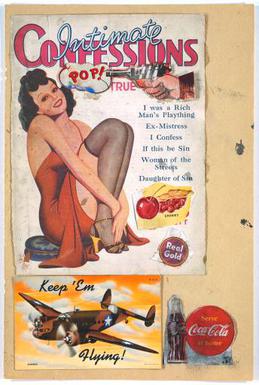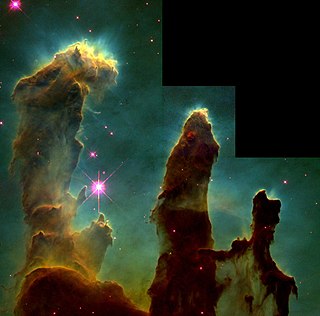Related Research Articles

The Apollo program, also known as Project Apollo, was the United States human spaceflight program carried out by the National Aeronautics and Space Administration (NASA), which succeeded in preparing and landing the first humans on the Moon from 1968 to 1972. It was first conceived in 1960 during President Dwight D. Eisenhower's administration as a three-person spacecraft to follow the one-person Project Mercury, which put the first Americans in space. Apollo was later dedicated to President John F. Kennedy's national goal for the 1960s of "landing a man on the Moon and returning him safely to the Earth" in an address to Congress on May 25, 1961. It was the third US human spaceflight program to fly, preceded by the two-person Project Gemini conceived in 1961 to extend spaceflight capability in support of Apollo.

Space exploration is the use of astronomy and space technology to explore outer space. While the exploration of space is currently carried out mainly by astronomers with telescopes, its physical exploration is conducted both by uncrewed robotic space probes and human spaceflight. Space exploration, like its classical form astronomy, is one of the main sources for space science.

Luna 16 was an uncrewed 1970 space mission, part of the Soviet Luna program. It was the first robotic probe to land on the Moon and return a sample of lunar soil to Earth. The 101 grams sample was returned from Mare Fecunditatis. It represented the first successful lunar sample return mission by the Soviet Union and was the third lunar sample return mission overall.

Pop art is an art movement that emerged in the United Kingdom and the United States during the mid- to late-1950s. The movement presented a challenge to traditions of fine art by including imagery from popular and mass culture, such as advertising, comic books and mundane mass-produced objects. One of its aims is to use images of popular culture in art, emphasizing the banal or kitschy elements of any culture, most often through the use of irony. It is also associated with the artists' use of mechanical means of reproduction or rendering techniques. In pop art, material is sometimes visually removed from its known context, isolated, or combined with unrelated material.

Milton Ernest "Robert" Rauschenberg was an American painter and graphic artist whose early works anticipated the Pop art movement. Rauschenberg is well known for his Combines (1954–1964), a group of artworks which incorporated everyday objects as art materials and which blurred the distinctions between painting and sculpture. Rauschenberg was both a painter and a sculptor, but he also worked with photography, printmaking, papermaking and performance.

James Edwin Webb was an American government official who served as Undersecretary of State from 1949 to 1952. He was the second Administrator of NASA from February 14, 1961, to October 7, 1968. Webb led NASA from the beginning of the Kennedy administration through the end of the Johnson administration, thus overseeing each of the critical first crewed missions throughout the Mercury and Gemini programs until days before the launch of the first Apollo mission. He also dealt with the Apollo 1 fire.

The Vision for Space Exploration (VSE) was a plan for space exploration announced on January 14, 2004 by President George W. Bush. It was conceived as a response to the Space Shuttle Columbia disaster, the state of human spaceflight at NASA, and as a way to regain public enthusiasm for space exploration.
The Lunar Precursor Robotic Program (LPRP) is a NASA program that uses robotic spacecraft to prepare for future crewed missions to the Moon. The program gathers data such as lunar radiation, surface imaging, areas of scientific interest, temperature and lighting conditions, and potential resource identification.

Fallen Astronaut is a 3.5-inch (8.9 cm) aluminum sculpture created by Belgian artist Paul Van Hoeydonck. It is a stylized figure of an astronaut in a spacesuit, intended to commemorate the astronauts and cosmonauts who have died in the advancement of space exploration. It was commissioned and placed on the Moon by the crew of Apollo 15 at Hadley Rille on August 2, 1971, UTC, next to a plaque listing 14 names of those who died up to that time. The statue lies on the ground among several footprints.

The Universities Space Research Association (USRA) was incorporated on March 12, 1969, in Washington, D.C. as a private, nonprofit corporation under the auspices of the National Academy of Sciences (NAS). Institutional membership in the association currently stands at 113 universities. All member institutions have graduate programs in space sciences or technology. Besides the 98 member institutions in the United States, there are two member institutions in Canada, four in Europe, two in Israel, one in Australia and one in New Zealand, one in Hong Kong, two in Korea and two in the United Kingdom.

"Space art", also known as "astronomical art", is the term for a genre of modern artistic expression that uses the universe as a frame of reference. Like other genres, space art has many facets and encompasses realism, impressionism, hardware art, sculpture, abstract imagery, and zoological art. Though artists have long produced art with astronomical elements, the genre of space art itself is still in its infancy, having begun only when technological advancement allowed for more detailed observation of the night sky. Regardless of style, space art attempts to communicate ideas somehow related to space, often including an artistic interpretation of varied cosmological phenomena and scientific discoveries. In some cases, artists who consider themselves space artists use more than illustration and painting to communicate astronomy or works depicting space, with some working directly with space flight technology and scientists in attempts to expand the arts, humanities, and cultural expression relative to space exploration.

The National Aeronautics and Space Administration is an independent agency of the U.S. federal government responsible for the civil space program, aeronautics research, and space research. Established in 1958, NASA succeeded the National Advisory Committee for Aeronautics (NACA) to give the U.S. space development effort a distinctly civilian orientation, emphasizing peaceful applications in space science. NASA has since led most American space exploration, including Project Mercury, Project Gemini, the 1968–1972 Apollo Moon landing missions, the Skylab space station, and the Space Shuttle. NASA currently supports the International Space Station and oversees the development of the Orion spacecraft and the Space Launch System for the crewed lunar Artemis program, the Commercial Crew spacecraft, and the planned Lunar Gateway space station.
The Foundation for Contemporary Arts (FCA), is a nonprofit based foundation in New York City that offers financial support and recognition to contemporary performing and visual artists through awards for artistic innovation and potential. It was established in 1963 as the Foundation for Contemporary Performance Arts by artists Jasper Johns, John Cage, and others.
With the advent of robotic and human spaceflight a new era of American history had presented itself. Keeping with the tradition of honoring the country's history on U.S. postage stamps, the U.S. Post Office began commemorating the various events with its commemorative postage stamp issues. The first U.S. Postage issue to depict a U.S. space vehicle was issued in 1948, the Fort Bliss issue. The first issue to commemorate a space project by name was the ECHO I communications satellite commemorative issue of 1960. Next was the Project Mercury issue of 1962. As U.S. space exploration progressed a variety of other commemorative issues followed, many of which bear accurate depictions of satellites, space capsules, Apollo Lunar Modules, space suits, and other items of interest.
The NASA RealWorld - InWorld Engineering Design Challenge is an educational activity designed for students in grades 7–12. It aims to develop skills relevant to careers in science, technology, engineering, and math (STEM) fields. The challenge consists of two phases: project-based learning and team competitions. Students, supported by teachers and coaches, engage in solving engineering problems inspired by NASA and collaborate with university students and engineering mentors in a virtual reality environment. The focus of the challenge revolves around real-world issues related to the James Webb Space Telescope and the Robonaut 2 humanoid robot. By working on these problems, students contribute to finding practical solutions that align with ongoing research efforts. The RealWorld - InWorld initiative is a collaborative educational program between NASA, the National Institute of Aerospace (NIA), and USA TODAY Education. It builds upon the Sight/Insight design challenge developed by NASA and USA TODAY Education, as well as the Virtual Exploration Sustainability Challenge (VESC) developed by NIA and NASA. These initiatives share a common foundation of using NASA themes and content to engage and educate students in grades 7–12.

Moon Museum is a small ceramic wafer three-quarters by one-half inch in size, containing artworks by six prominent artists from the late 1960s. The artists with works in the "museum" are Robert Rauschenberg, David Novros, John Chamberlain, Claes Oldenburg, Forrest Myers and Andy Warhol.

Paul Calle was an American artist who was best known for the designs he created for postage stamps, including 40 that were released by the United States Postal Service, and others for stamps issued by the Federated States of Micronesia, the Marshall Islands, Sweden and the United Nations. The sole artist hired by NASA to cover the Apollo 11 astronauts up close, Calle designed the 10-cent stamp that commemorated the first crewed Moon landing; it depicted an astronaut stepping onto the Moon from the lunar module, with the Earth visible over the Moon's horizon.
David Ross Novros, is an American artist. He is known for his minimalist geometric paintings, shaped canvases, and his use of color. He has also studied fresco painting extensively.
References
- ↑ "Soaring: Works from the NASA Art Program, Celebrating NASA Langley's Centennial Anniversary". pfac-va.org. Peninsula Fine Arts Center. Retrieved 1 October 2018.
- 1 2 Bert, Ulrich. "NASA and the Arts".
- ↑ Meier, Allison (29 August 2013). "Art in the Outer Limits: A Look at NASA's Space Art Program". hyperallergic.com. Hyperallergic. Retrieved 1 October 2018.
- ↑ Goodyear, Anne Collins, The Relationship of Art to Science and Technology in the United States, 1957-1971: Five Case Studies, ProQuest 305503573
- 1 2 3 4 Hotovy, Hannah (2017-04-12). "NASA and Art: A Collaboration Colored with History". NASA. Retrieved 2018-11-06.
- 1 2 3 4 5 6 Collins, Anne. "Art, technology, and the American space program, 1962-1972". go.galegroup.com.ccclibrary.idm.oclc.org. Retrieved 2018-11-06.
- 1 2 3 Siceloff, Steven (15 May 2009). "NASA - Artists Give NASA a Different Light". www.nasa.gov. Retrieved 2018-11-06.
- 1 2 3 4 5 6 7 8 9 10 11 "nasaartspace". Flickr. Retrieved 2018-11-06.
- ↑ Cooke, Hereward Lester (1972). Eyewitness to Space. New York: Harry N. Abrams, Inc. p. 227. Bibcode:1971ets..book.....C.
- ↑ Marta Wiktoria Bryll, Eyewitness to Space: The NASA Art Program, dailyartmagazine.com, 12 April 2022
- ↑ Fox, Margalit (31 December 2010). "Paul Calle, Postage Stamp Designer, Is Dead at 82". The New York Times. Retrieved 2018-11-06.
- ↑ Schmid, Beth (September 29, 1988). "NASA's Art Program Captures What the Camera Can't". NASA Magazine (Spring 1992): 11–17. Retrieved 1 October 2018.
- ↑ Schulman, Robert (1988). Visions of flight : a retrospective from the NASA Art Collection. United States. National Aeronautics and Space Administration (NASA). p. 3. Retrieved 1 October 2018.